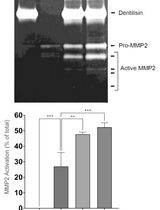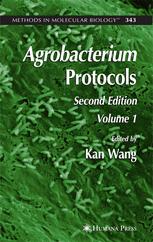- EN - English
- CN - 中文
Ensifer-mediated Arabidopsis thaliana Root Transformation (E-ART): A Protocol to Analyse the Factors that Support Ensifer-mediated Transformation (EMT) of Plant Cells
剑菌介导的拟南芥根系转化(E-ART): 分析利于剑菌介导植物细胞转化(EMT)因素的实验方案
发布: 2017年10月05日第7卷第19期 DOI: 10.21769/BioProtoc.2564 浏览次数: 11507
评审: Anonymous reviewer(s)

相关实验方案

通过制备连续聚丙烯酰胺凝胶电泳和凝胶酶谱分析法纯化来自梭状龋齿螺旋体的天然Dentilisin复合物及其功能分析
Pachiyappan Kamarajan [...] Yvonne L. Kapila
2024年04月05日 1655 阅读
Abstract
Ensifer adhaerens OV14, a soil borne alpha-proteobacteria of the Rhizobiaceae family, fortifies the novel plant transformation technology platform termed ‘Ensifer-mediated transformation’ (EMT). EMT can stably transform both monocot and dicot species, and the host range of EMT is continuously expanding across a diverse range of crop species. In this protocol, we adapted a previously published account that describes the use of Arabidopsis thaliana roots to investigate the interaction of A. thaliana and Agrobacterium tumefaciens. In our laboratory, we routinely use A. thaliana root explants to examine the factors that enhance the utility of EMT. In addition, the E-ART protocol can be used to study the transcriptional response of E. adhaerens and host plant following exposure to explant tissue, the transformability of different Ensifer adhaerens strains/mutants as well as testing the susceptibility of A. thaliana mutant lines as a means to decipher the mechanisms underpinning EMT.
Keywords: Ensifer adhaerens strain OV14 (附着剑菌菌株OV14)Background
The advancement of Ensifer-mediated transformation (EMT) technology to successfully transform dicots viz., Arabidopsis thaliana, Solanum tuberosum, Nicotiana tabacum, Manihot esculenta, Brassica napus, and the monocot; Oryza sativa, has been previously reported (Wendt et al., 2012; Zuniga-Soto et al., 2015; Chavarriaga-Aguirre et al., 2016; Rathore et al., 2016). Additionally, genomic analysis of E. adhaerens OV14 by Rudder et al. (2014) revealed the bacterium possessed a 7.7 Mb genome comprised of two circular chromosomes (3.96 Mb and 2.01 Mb) and two plasmids (1.61 Mb and 125 Kb). A comparative analysis of the genome of E. adhaerens OV14 with Agrobacterium tumefaciens C58 (classic genetic engineer) and Sinorhizobium meliloti 1021 (a rhizobia with a propensity for low rates of genetic transformation; Broothaerts et al., 2005), highlighted that both E. adhaerens OV14 and S. meliloti 1021 contain homologs to several chromosomal-based genes essential for Agrobacterium-mediated transformation (AMT). However, a suite of genes which positively influence the successful transformation of a plant genome were found to be only present in the genome of E. adhaerens OV14 but absent from S. meliloti 1021 (Rudder et al., 2014). Overall, the sequence analysis of the E. adhaerens OV14 genome has significantly expanded the knowledge base describing the genetic systems that regulate the transformation of plant genomes via EMT.
To date several transient transformation systems have been proposed to study gene function in plants in regard to the use of A. tumefaciens (Wroblewski et al., 2005; Gelvin, 2006; Bhaskar et al., 2009; Li et al., 2009; Van Loock et al., 2010; Hwang et al., 2013; Krenek et al., 2015). Whereas, the stable transformations of any plant species are lengthy processes to test the utility of a bacterial transfection system to transform the plants. The advantages of transient transformation methods include rapid production of results, functional genomic studies and recombinant protein production (Van Loock et al., 2010; Krenek et al., 2015). The model plant A. thaliana is a powerful research tool with which to study the molecular, genetic and biochemical processes that support genetic transformation of somatic tissues as well as in planta (Provart et al., 2016). In contrast to the several months typically required for the transformation of primary crop species, these investigations require a rapid, reproducible and easy quantification method to determine the rate of transient transformation. Previously, Gelvin (2006) reported an efficient and reproducible quantitative assay for Agrobacterium-mediated Transformation using A. thaliana roots. This assay has well served the purpose of testing either Agrobacterium strains or A. thaliana ecotypes/mutants in the authors’ laboratory for more than two decades, reflecting the significance and competency of the assay in publications such as Shi et al. (2014). Conversely, a transient transformation method to facilitate comparable studies via EMT is not available. In response, the Ensifer-mediated A. thaliana Root Transformation (E-ART) protocol presented here is designed to address this deficit so that specific genetic and microbiological factors that support/enhance EMT can be identified to support the application of the technology to agronomically important crop species. The protocol is a modified version of an existing AMT based quantitative A. thaliana roots assay (Gelvin, 2006). While developing the E-ART protocol, we learnt that it is possible to improve transient GUS expression in A. thaliana root segments by adjusting several experimental factors (e.g., time of co-cultivation, acetosyringone concentrations, etc.) involved in the early stages of E. adhaerens transfection. E-ART, being the first quantitative method of transient gene expression for EMT will facilitate the rapid evaluation of novel E. adhaerens strains in plant transformation while also providing a platform to assess the genetic response of plants to EMT.
Materials and Reagents
- 2 ml centrifuge tubes
- Square Petri-dishes (Greiner Bio One International, catalog number: 688161 )
- Parafilm (Bemis, catalog number: PM992 )
- 50 ml Falcon tube
- Scalpel blades (NO. 10A, Swan Morton, catalog number: 0302 )
- Sterile filter papers (GE Healthcare, catalog number: 1004-090 )
- Petri dish 92 x 16 mm w/o cams (SARSTEDT, catalog number: 82.1472 )
- A. thaliana seed (in this case ecotype Columbia, Col-0)
Note: A. thaliana seed is no more than 6 months old being stored at 4 °C.
- E. adhaerens strain OV14 harbouring plasmid of choice (in this case pCambia5105/pCambia5106 plasmids [Jefferson et al., 2006])
- 70% ethanol
- Distilled sterile water (DSW)
- Bleach (5% sodium hypochlorite; final concentration used is 50% Bleach, i.e., 1:1 Bleach:water)
- Tween-20
- Agarose (0.1%, Sigma-Aldrich, catalog number: A9539-500G )
- Antibiotics for bacterial selection: kanamycin, streptomycin, spectinomycin (Duchefa Biochemie)
- Sodium chloride (0.9% NaCl solution)
- Acetosyringone (Sigma-Aldrich, catalog number: D134406 )
- Cefotaxime sodium (Duchefa Biochemie, catalog number: C0111.0005 )
- Tryptone (Oxoid, catalog number: LP0042 )
- Yeast extract (Oxoid, catalog number: LP0021 )
- Calcium chloride dehydrate (Duchefa Biochemie, catalog number: C0504 )
- Agar No. 1 (Oxoid, catalog number: LP0011 )
- MS basal salts (Duchefa Biochemie, catalog number: M0221 )
- Sucrose (Duchefa Biochemie, catalog number: S0809 )
- 2,4-Morpholino-ethane sulfonic acid (MES monohydrate) (Duchefa Biochemie, catalog number: M1503 )
- Myo-inositol (Duchefa Biochemie, catalog number: I0609 )
- Nicotinic acid (Duchefa Biochemie, catalog number: N0611 )
- Pyridoxine (Duchefa Biochemie, catalog number: P0612 )
- Thiamine-HCl (Duchefa Biochemie, catalog number: T0614 )
- D-Glucose monohydrate (Duchefa Biochemie, catalog number: G0802 )
- Indole-3-acetic acid (IAA) (Duchefa Biochemie, catalog number: I0901 )
- 2,4-Dicholorophenocxyacetic acid (2,4-D) (Duchefa Biochemie, catalog number: D0911 )
- Kinetin (Duchefa Biochemie, catalog number: K0905 )
- X-GlcA cyclohexylammonium salt (Duchefa Biochemie, catalog number: X1405 )
- Dimethyl sulfoxide (DMSO) (Duchefa Biochemie, catalog number: D1370 )
- Teagasc-Tryptone Yeast-extract (TTY) medium (Rathore et al., 2015) (see Recipes)
- MS based media (see Recipes)
- Seed germination media (SGM)
- Co-cultivation media (CCM)
- Callus Induction media (CIM)
- Vitamin stock
- Seed germination media (SGM)
- X-GlcA solution (see Recipes)
- Histochemical GUS stain solution (Jefferson et al., 1987) (see Recipes)
Equipment
- Pipettes (P1000, P100, P10)
- Controlled environment room/chamber to grow healthy A. thaliana plants (24 °C, 16 h light, 8 h dark), abbreviated as CT room
- Conical flasks (250 ml, sterile)
- Centrifuge
- Incubator (28 °C and 37 °C)
- Shaker incubator (28 °C, 220 rpm)
- Fridge (4 °C) and freezers (-20 °C and -80 °C)
- Laminar flow to perform aseptic work
- Bead sterilizer/flame to sterilize forceps
- Scalpel blades handles (No.7 S/S, Swan Morton, catalog number: 0907 )
- Autoclave (15 min at 121 °C and 15 psi)
- pH meter
- Weighing balance
- NanoDrop2000 spectrophotometer (Thermo Fisher Scientific, Thermo ScientificTM, model: NanoDropTM 2000 )
- Elga water purifier (Veolia Water Solution & Technologies, model: PURELAB® OPTION-R 7, catalog number: OR007BPM1 )
- Stereo-microscope
Software
- SAS system (Version 9.3, copyright 2002-2010 by SAS Institute Inc., Cary, NC, USA)
Procedure
文章信息
版权信息
© 2017 The Authors; exclusive licensee Bio-protocol LLC.
如何引用
Rathore, D. S., Doohan, F. M. and Mullins, E. (2017). Ensifer-mediated Arabidopsis thaliana Root Transformation (E-ART): A Protocol to Analyse the Factors that Support Ensifer-mediated Transformation (EMT) of Plant Cells. Bio-protocol 7(19): e2564. DOI: 10.21769/BioProtoc.2564.
分类
植物科学 > 植物转化 > Ensifer介导的转化
微生物学 > 微生物-宿主相互作用 > 细菌
分子生物学 > DNA > 转化
您对这篇实验方法有问题吗?
在此处发布您的问题,我们将邀请本文作者来回答。同时,我们会将您的问题发布到Bio-protocol Exchange,以便寻求社区成员的帮助。
提问指南
+ 问题描述
写下详细的问题描述,包括所有有助于他人回答您问题的信息(例如实验过程、条件和相关图像等)。
Share
Bluesky
X
Copy link












